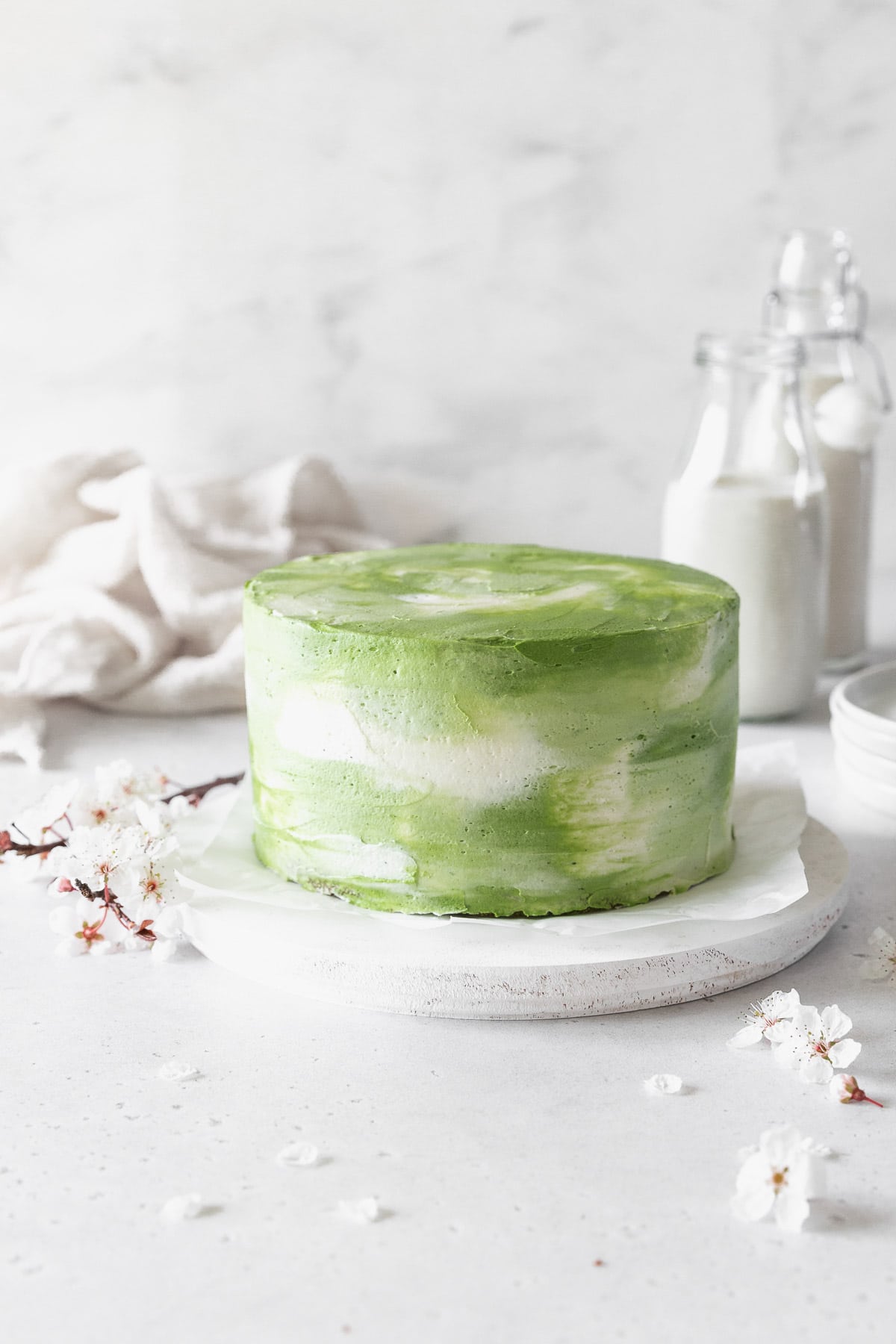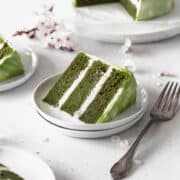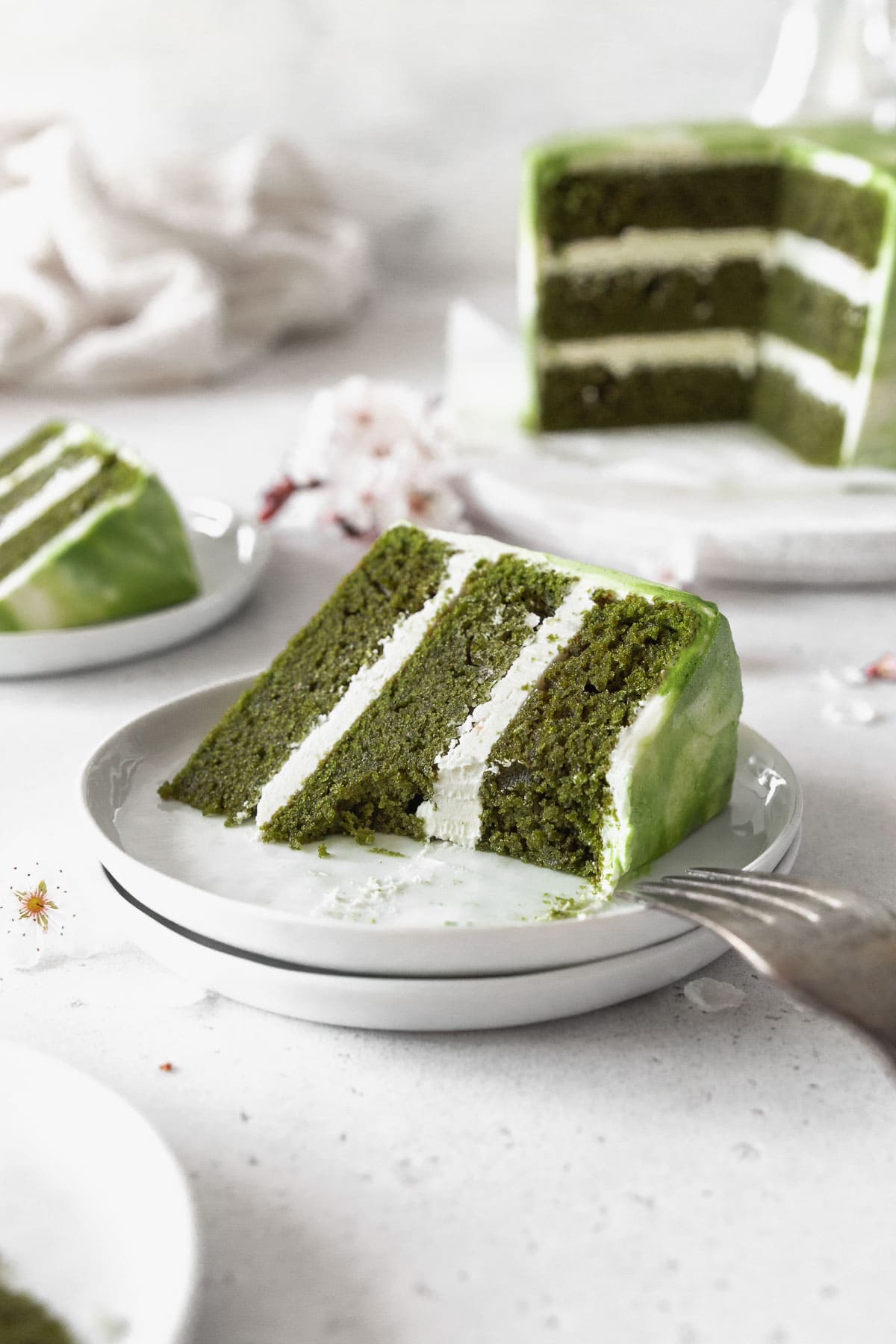This matcha cake is made with layers of soft, fluffy matcha sponge and a creamy matcha and vanilla buttercream frosting. The matcha adds a cozy and earthy flavor that balances the sweetness perfectly, and is decorated beautifully using a watercolor frosting technique.
Growing up in Japan, I’ve loved matcha treats for as long as I can remember—even taking tea ceremony classes in high school! So when I, a matcha lover with high standards, say this cake is good, you can trust it’s been well tested and made with a lot of love.

Recipe Highlights
Here are some notes about this matcha cake recipe before you start baking:
- Soft & Fluffy: Thanks to the combination of cake flour, Greek yogurt, and oil, the cake layers are soft and airy, yet moist—it's just right!
- Full of Matcha: There's matcha in boththe cake and the frosting, so if you like the taste of green tea, you are going to love this cake!
- Beautiful: The watercolor frosting technique is pretty but it's also surprisingly easy to do! All you'll need are vanilla frosting, matcha frosting, a spatula, and a turntable cake stand.
- Easily Adaptable: If you or someone you're baking for has dietary restrictions, I've got you. This recipe can be adjusted to being both gluten and dairy free without losing flavor or texture!
A Deep Dive Into Matcha
For the best flavor and color, I recommend using ceremonial grade matcha rather than culinary grade matcha.
Ceremonial matcha is a higher grade of matcha that’s selected for traditional Japanese tea ceremony. Culinary grade matcha is a yellowish brownish green in color, the texture is slightly gritty, and the flavor is bitter. On the other hand, the ceremonial grade is a vibrant green powder that’s very fine, and has a sweet grassy flavor.
Although ceremonial matcha is more expensive, I always recommend it over culinary matcha. My favorite matcha brand AKA Tea—they sell small-batch spray-free ceremonial grade matcha.
Ingredients Needed & Key Notes
Here are a few of the key ingredients in this recipe. You can find the full list of ingredients below in the recipe card.
Cake flour: Cake flour has a lower protein content than all-purpose flour, creating a more delicate and tender sponge cake. If you don’t have cake flour, you can substitute it by mixing 1¼ cup all-purpose flour and ¼ cup cornstarch. It’s not an exact dupe, but it’ll work in a pinch.
Butter & Oil: I like using both, as the butter adds richness while the oil adds moisture and tenderness. If you only have salted butter, reduce the salt in the cake by ¼ teaspoon and omit the salt in the buttercream. For the oil, be sure to use a neutral flavored oil, like avocado or light olive oil. Avoid oils with strong flavors like extra virgin olive oil and coconut oil, which will also make your cake harden if you refrigerate it.
Gluten-Free: To make this matcha cake recipe gluten-free, combine 1¼ cup (185g) of Bob's Red Mill 1-to-1 flour blend and ¼ cup cornstarch. Make sure to let the batter rest for 20 to 30 minutes before baking, to allow the flour to properly hydrate and prevent the cake layers from having a gritty texture.
Dairy-Free: To make this dairy-free, substitute the butter with equal amounts vegan butter sticks or more oil. The greek yogurt can be substituted with equal amounts of mayonnaise, which may sound odd, but I promise it works and you won’t taste it at all! Mayo is a combination of eggs, oil, and vinegar so there’s nothing funky in there—don’t knock it ‘til you try it! You can use plain non-dairy milk for the whole milk.

How to Make the Perfect Matcha Cake
Weigh the flour. Scooping or spooning and leveling the flour isn't an accurate way to measure flour, and it often makes the cakes dense and dry. Keep your cake moist and tender by weighing the flour with a kitchen scale!
Let the cakes cool completely. This will keep the frosting from melting on the cake and will generally make cake assembly so much easier.
Don't overmix the batter. Stir just until the streaks of flour absorb into the batter. Overmixing will create a tough or rubbery cake, unless you're using gluten-free flour, in which case, mix away!
Cut the cake domes off. By measuring the layers and cutting the domes off, you'll end up with even layers that'll not only look cleaner once the cake is sliced, but the cake won't be lopsided.

Matcha Cake Recipe
Ingredients
Matcha cake
- 1¾ cups cake flour
- ½ teaspoon fine salt
- ½ teaspoon baking soda
- 1½ teaspoons baking powder
- 2 tablespoons matcha powder
- 1 cup granulated sugar
- ¼ cup unsalted butter softened at room temperature
- 2 large eggs
- ⅓ cup greek yogurt
- ¼ cup oil use a neutral flavor oil like avocado or light olive oil
- ⅔ cup whole milk
Buttercream frosting
- 1 cup unsalted butter softened at room temperature
- ⅓ cup shortening softened at room temperature
- 3 cups powdered sugar
- ¼ teaspoon fine salt
- 1 teaspoon vanilla extract
- 1 tablespoon matcha powder
Instructions
Matcha cake
- Preheat the oven to 340°F (170°C) and grease and line the bottoms of three 6-inch round pans, or two 8-inch round pans with parchment paper.
- In a large bowl, whisk together the cake flour, salt, baking soda, baking powder, matcha, and granulated sugar until combined. Add the softened butter and work it into the flour until it turns into a sandy mixture.
- In a separate bowl, whisk together the eggs, Greek yogurt, and oil until smooth. Pour this mixture into the dry ingredients and stir until combined. Add the milk and stir just until a smooth batter forms. Be sure not to overmix.
- Evenly pour the batter into the cake pans and bake in the oven for 23-25 minutes, or until a toothpick inserted into the center comes out clean. Let the cakes cool in the pan for 5 minutes before taking them out onto a wire rack to cool completely.
- Optional: Once the cake layers have cooled, slice the domes off using a serrated knife, to create flat, even cake layers.
Buttercream frosting
- In the bowl of a stand mixer, or using a large bowl and an electric hand mixer, beat the softened butter and shortening until light and fluffy, about 3 minutes. Add the powdered sugar ½ cup at a time, beating after each addition. Beat in the salt and vanilla. Sample the frosting and add more powdered sugar if needed for a sweeter frosting.
- Prepare two small bowls and add ¼ of the vanilla buttercream to each bowl. In one bowl, add ½ teaspoon of matcha powder and stir until the frosting turns into a pastel green color. In the other bowl, add the remaining 2½ teaspoons of matcha powder and stir to make a darker green frosting.
Assembly
- On a cake turntable, place one of the matcha cakes. Add some vanilla buttercream (I used about ½ cup) and spread it out evenly using a knife or offset spatula. Place your second cake layer on top and spread on another layer of buttercream. Place your final layer of cake on top and cover the entire cake with buttercream, smoothing out the sides and top.
- Using a knife or spatula, add dollops of vanilla and matcha buttercream all around the cake.
- Using a cake scraper or a long spatula, smooth out the sides while turning the turntable to create a watercolor design.
Nutrition
Storage Directions
Storing: This cake keeps covered in an airtight container at room temperature for up to 3 days. It can keep covered in an airtight container in the refrigerator for up to 5 days.
Freezing: Wrap each slice with a couple layers of plastic wrap, and put them in a freezer bag. You can keep them frozen for up to 2 months. Defrost the cake in the refrigerator overnight before serving.

FAQs
Matcha can provide a slightly earthy and vegetal taste, with subtle notes of sweetness and bitterness, to baked goods. When paired with sweeter flavors like vanilla, chocolate, or citrus, the result is a balanced and flavorful dessert.
Matcha cake turns brown when the cake is either overbaked or the quality of the matcha is low, or the matcha is old. To ensure a beautifully green cake, make sure the matcha you're using is fresh ceremonial grade matcha, and keep an eye on the oven so you don't overbake the cake.
Your cake can deflate if your baking powder has expired, or if you opened the oven door while you were baking the cake. Always be sure to use fresh baking powder, or check to see if it’s still good by adding a spoonful to a small bowl and splash some hot water—if it bubbles, it’s good to use! And keep the oven door closed for at least 23 minutes before taking the cake out to test it with a toothpick inserted in the center.
Yes! Besides vanilla buttercream and matcha buttercream, this cake would pair well with cream cheese frosting as well as whipped cream.
This cake calls for 3 tablespoons of matcha powder, which contain 630g of caffeine. Divided among the 10 slices of cake, each slice of matcha cake contains 60-65g of caffeine or the amount of caffeine in about half a cup of coffee.
More Cake Recipes
If you want more matcha desserts, make these matcha cupcakes. They're so fluffy and topped with a white chocolate buttercream!
This icebox cake is perfect if you're not in the mood to turn on your oven. It's a no-bake dessert but it's so creamy and delicious!
Are you gluten-free? Make this gluten-free chocolate cake or gluten-free German chocolate cake immediately! They're both so moist and decadent.
This lemon curd cake has the perfect balance between sweet and zesty. The lemon curd layers are so silky and delicious!
This banana upside down cake is perfect for anyone who has one too many overripe bananas in their kitchen.
















Leave a Reply